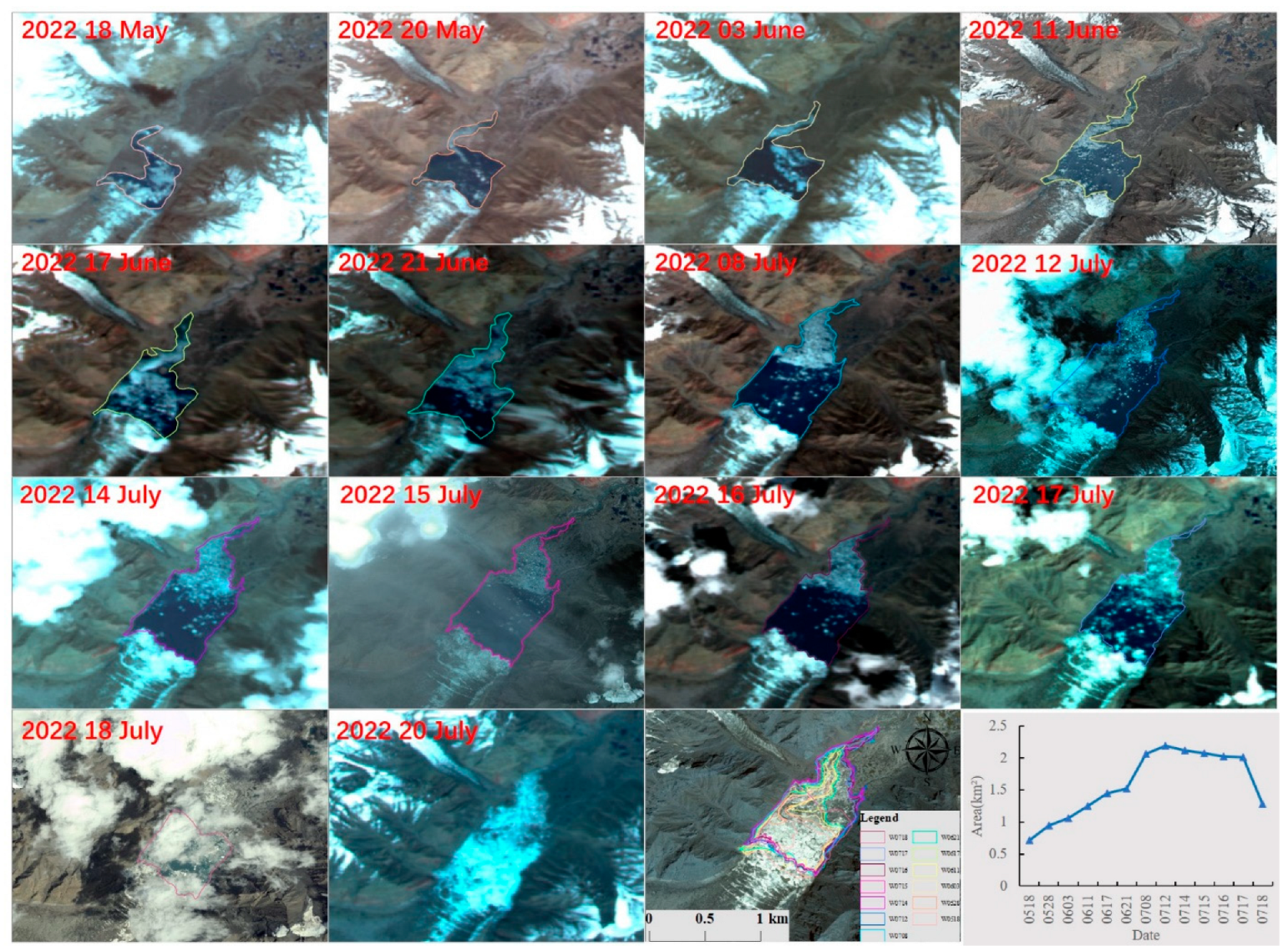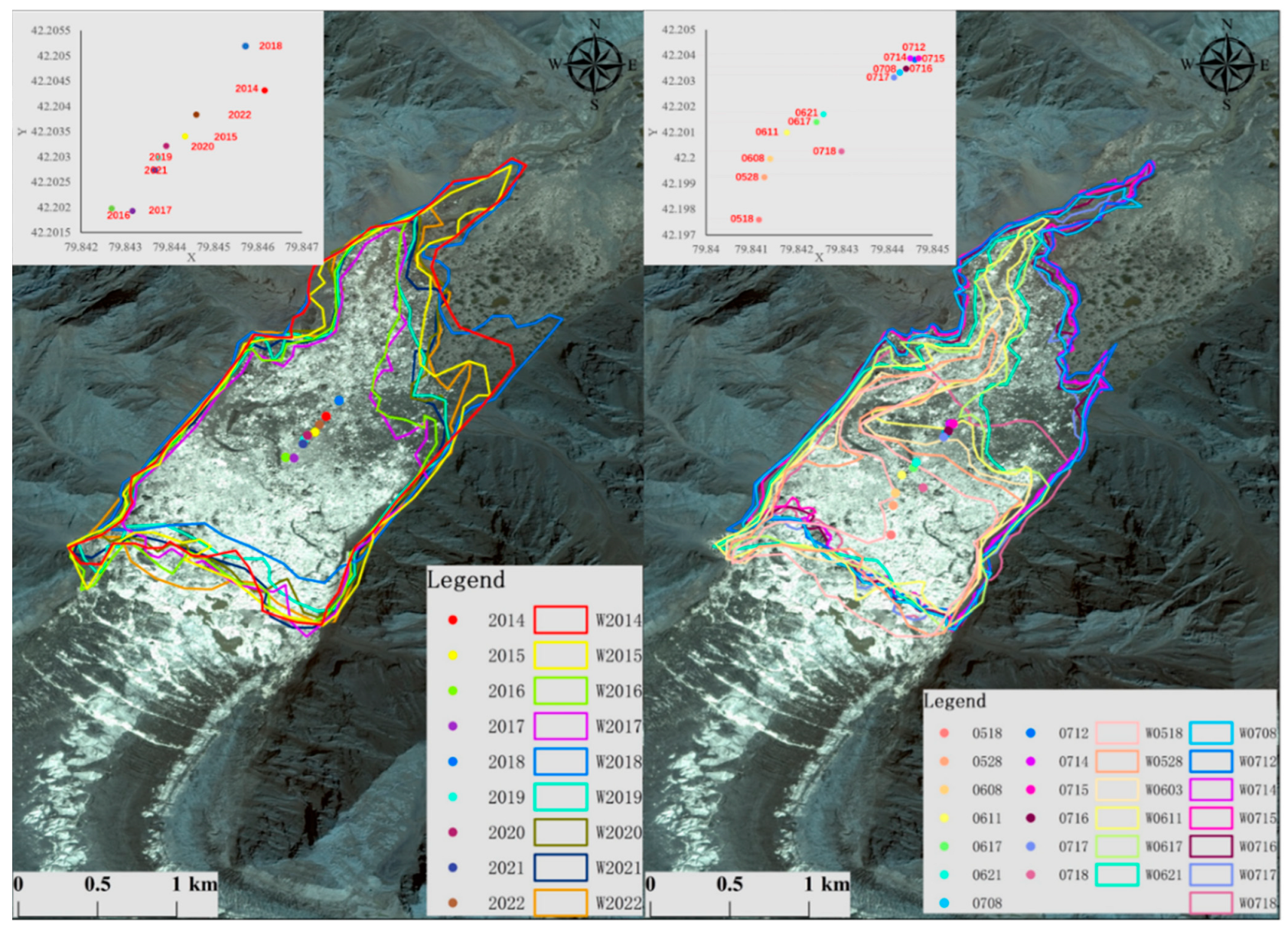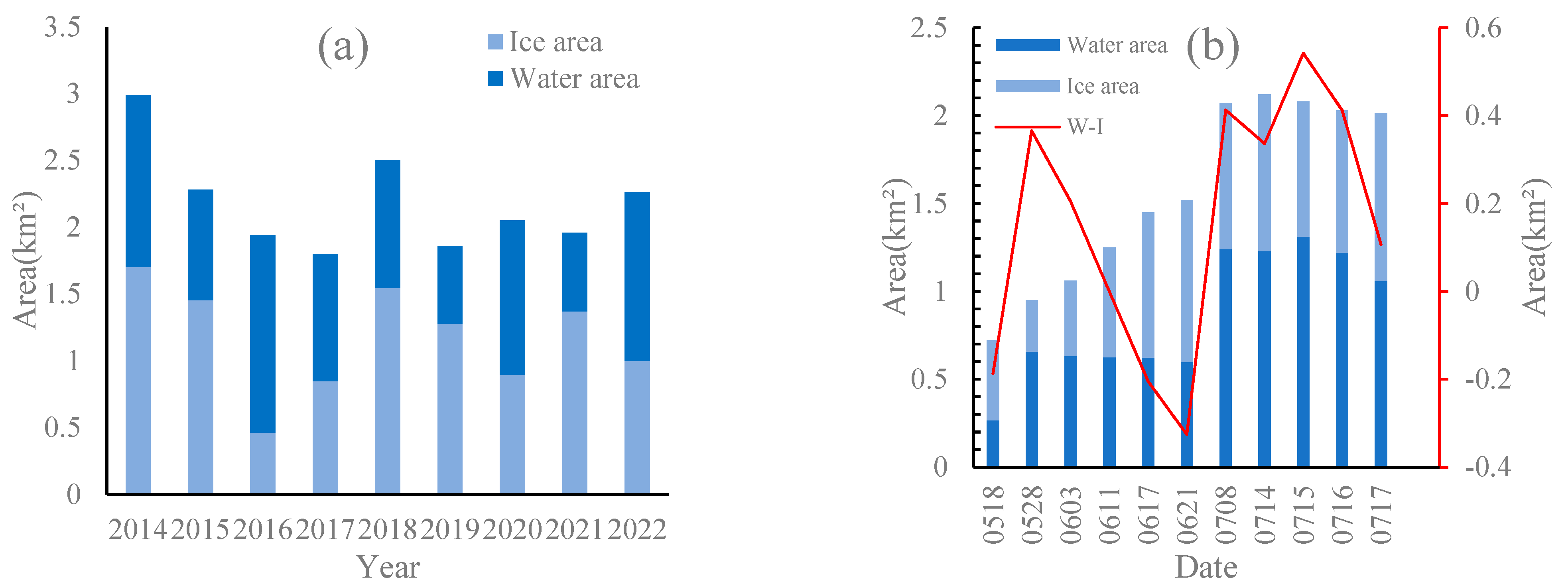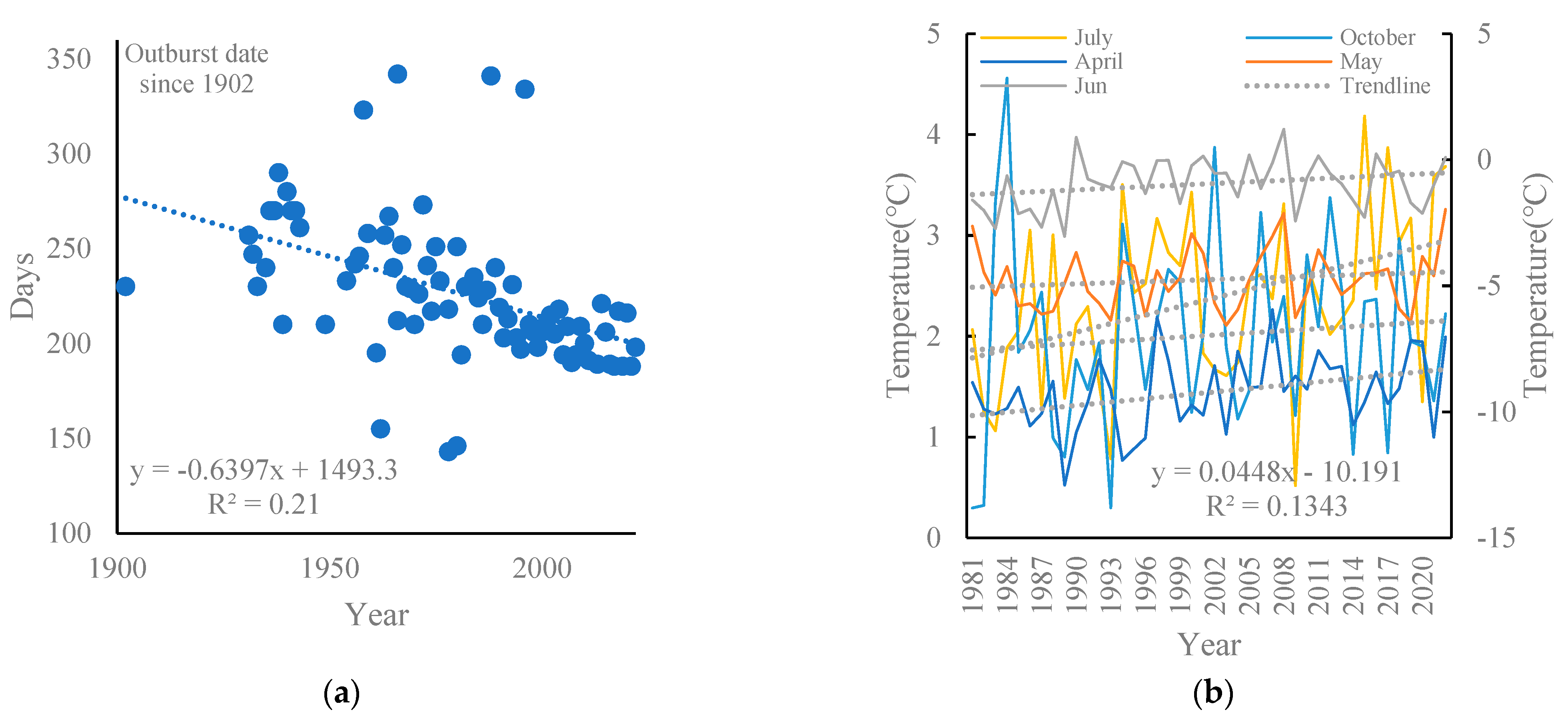Monitoring Glacier Lake Outburst Flood (GLOF) of Lake Merzbacher Using Dense Chinese High-Resolution Satellite Images
Abstract
:1. Introduction
2. Materials and Methods
2.1. Study Area
2.2. Data Sources
- Satellite data: All the satellite images were obtained from China Centre for Resources Satellite Data and Application, Beijing, China, (https://data.cresda.cn/#/home, accessed on 24 February 2023), except for Beijing-2 (BJ-2), which was obtained from Twenty First Century Aerospace Technology Co., Ltd., Beijing, China (https://www.21at.com.cn/, accessed on 24 February 2023) (Table 1).
- 2.
- Climate data: The land surface temperature data used in the article come from the ERA5-LAND reanalysis dataset provided by the European Centre for Medium-Range Weather Forecasts (ECMWF) [48]. ERA5-LAND uses the simulated land–atmosphere variables from the ECMWF’s fifth-generation reanalysis product ERA5 as forcing and is obtained using the modified land surface hydrology model HTESSEL and CY45R1. Although it has not undergone data assimilation, the observational data indirectly affect its simulation results. Compared with ERA5, ERA5-LAND has a higher spatial resolution, with a horizontal resolution of up to 0.1° (9 km) and a temporal resolution of 1 h. Due to the limitation of currently available data (https://developers.google.com/earth-engine/datasets/catalog/ECMWF_ERA5_LAND_MONTHLY_BY_HOUR#description, accessed on 24 February 2023), the hourly land surface temperature data of ERA5-LAND from 1 January 1981 to 1 December 2022 in the study area was used in the study.
2.3. Methods
- Processing of the satellite images and climate data: Preprocessing methods are shared in multispectral data of GF-1, GF-6, HJ-2 A/B, and BJ-2, including five steps: (1) Radiometric calibration; (2) Atmospheric correction; (3) Orthorectification; (4) Image fusion; (5) Image registration. The radiometric calibration and atmospheric correction were performed with the ENVI FLAASH module [44]. After finishing the preprocessing, combining 2 m resolution panchromatic and 8 m resolution multispectral data by the ENVI Gram-Schmidt Pan-Sharpening module to enhance the spatial resolution of GF-1, GF-6, and BJ-2 images [45]. DSM with a 2 m spatial resolution was derived from GF-7 by using the rational polynomial coefficient (RPC) model [41]. Time series temperature data were extracted by Google Earth Engine (GEE) cloud platform (https://earthengine.google.com/, accessed on 24 February 2023).
- Lake area extraction and changes analysis. The visual interpretation method was applied in this study. To improve the interpretation accuracy, the normalized difference water index (NDWI) [47] was introduced to better distinguish water bodies (Figure 2). The NDWI can enhance the identification of water bodies and effectively distinguish water bodies from floating ice. By using the green channel (maximum reflectance of water) and the near-infrared (NIR) channel (minimum reflectance of water), the NDWI was calculated as below:
- 3.
- Uncertainty assessment of glacier lake area. Visual interpretation was employed in extracting the lake area, and errors are unavoidable. Research has shown that mixed pixels caused by spatial resolution are a key factor in error sources. Using an error of one pixel on either side of the defined lake boundary is more appropriate [49]. Therefore, the uncertainty of the individual lake area can be calculated as follows:where e is the absolute area error (m2) of each glacier lake, n represents the number of pixels on the lake boundary (approximately the ratio of lake circumference to spatial resolution), m is the area of each pixel in the remote sensing product, R is the relative error of a single lake, and A is the area of the lake. The area error obtained from the above equation shows that the total absolute area error of Lake Merzbacher is 0.08 km2, the average relative error is 0.22%, and the relative area error is between 0.2% and 0.68% (Table 4).
3. Results
3.1. Maximum Lake Area (MLA) Change before Outburst from 2014 to 2022
3.2. Using Lake Area and Ice Cover to Monitor Hazard of Glacier Lake Outburst Flood of Lake Merzbacher
3.3. The Relationship between the Temperature and the Outburst Date since 1980
4. Discussion
5. Conclusions
Supplementary Materials
Author Contributions
Funding
Data Availability Statement
Conflicts of Interest
References
- Osman, M.B.; Tierney, J.E.; Zhu, J.; Tardif, R.; Poulsen, C.J. Globally resolved surface temperatures since the Last Glacial Maximum. Nature 2021, 599, 239–244. [Google Scholar] [CrossRef]
- Hugonnet, R.; Mcnabb, R.; Berthier, E.; Menounos, B.; Kb, A. Accelerated global glacier mass loss in the early twenty-first century. Nature 2021, 592, 726–731. [Google Scholar] [CrossRef] [PubMed]
- Nie, Y.; Pritchard, H.D.; Liu, Q.; Hennig, T.; Wang, W.; Wang, X.; Liu, S.; Nepal, S.; Samyn, D.; Hewitt, K. Glacial change and hydrological implications in the Himalaya and Karakoram. Nat. Rev. Earth Environ. 2021, 2, 91–106. [Google Scholar] [CrossRef]
- Su, B.; Xiao, C.; Chen, D.; Huang, Y.; Che, Y.; Zhao, H.; Zou, M.; Guo, R.; Wang, X.; Li, X. Glacier change in China over past decades: Spatiotemporal patterns and influencing factors. Earth-Sci. Rev. 2022, 226, 103926. [Google Scholar] [CrossRef]
- Richardson, S.D.; Reynolds, J.M. An overview of glacial hazards in the Himalayas. Quat. Int. 2000, 65–66, 31–47. [Google Scholar] [CrossRef]
- Milner, A.M.; Khamis, K.; Battin, T.J.; Brittain, J.E.; Barrand, N.E.; Füreder, L.; Cauvy-Fraunié, S.; Gíslason, G.M.; Jacobsen, D.; Hannah, D.M. Glacier shrinkage driving global changes in downstream systems. Proc. Natl. Acad. Sci. USA 2017, 114, 9770–9778. [Google Scholar] [CrossRef] [Green Version]
- Stuart-Smith, R.F.; Roe, G.H.; Li, S.; Allen, M.R. Increased outburst flood hazard from Lake Palcacocha due to human-induced glacier retreat. Nat. Geosci. 2021, 14, 85–90. [Google Scholar] [CrossRef]
- Dan, H.S.; Burr, A.; Haritashya, U.K.; Kargel, J.S.; Strattman, K. Rapid worldwide growth of glacial lakes since 1990. Nat. Clim. Chang. 2020, 10, 939–945. [Google Scholar]
- Zheng, G.; Allen, S.K.; Bao, A.; Ballesteros-Cánovas, J.A.; Huss, M.; Zhang, G.; Li, J.; Yuan, Y.; Jiang, L.; Yu, T. Increasing risk of glacial lake outburst floods from future Third Pole deglaciation. Nat. Clim. Chang. 2021, 11, 411–417. [Google Scholar] [CrossRef]
- Zhang, G.; Yao, T.; Xie, H.; Wang, W.; Yang, W. An inventory of glacial lakes in the Third Pole region and their changes in response to global warming. Glob. Planet. Chang. 2015, 131, 148–157. [Google Scholar] [CrossRef]
- Veh, G.; Korup, O.; Walz, A. Hazard from Himalayan Glacier Lake Outburst Floods. Proc. Natl. Acad. Sci. USA 2019, 117, 907–912. [Google Scholar] [CrossRef]
- Taylor, C.; Robinson, T.R.; Dunning, S.; Rachel Carr, J.; Westoby, M. Glacial lake outburst floods threaten millions globally. Nat. Commun. 2023, 14, 487. [Google Scholar] [CrossRef]
- Wangchuk, S.; Bolch, T.; Robson, B.A. Monitoring glacial lake outburst flood susceptibility using Sentinel-1 SAR data, Google Earth Engine, and persistent scatterer interferometry. Remote Sens. Environ. 2022, 271, 112910. [Google Scholar] [CrossRef]
- Maurer, J.M.; Schaefer, J.M.; Russell, J.B.; Rupper, S.; Wangdi, N.; Putnam, A.E.; Young, N. Seismic observations, numerical modeling, and geomorphic analysis of a glacier lake outburst flood in the Himalayas. Sci. Adv. 2020, 6, a3645. [Google Scholar] [CrossRef] [PubMed]
- Aggarwal, S.; Rai, S.C.; Thakur, P.K.; Emmer, A. Inventory and recently increasing GLOF susceptibility of glacial lakes in Sikkim, Eastern Himalaya. Geomorphology 2017, 295, 39–54. [Google Scholar] [CrossRef]
- Xie, Z.; ShangGuan, D.; Zhang, S.; Ding, Y.; Liu, S. Index for hazard of Glacier Lake Outburst flood of Lake Merzbacher by satellite-based monitoring of lake area and ice cover. Glob. Planet. Chang. 2013, 107, 229–237. [Google Scholar] [CrossRef]
- Shangguan, D.; Ding, Y.; Liu, S.; Xie, Z.; Pieczonka, T.; Xu, J.; Moldobekov, B. Quick Release of Internal Water Storage in a Glacier Leads to Underestimation of the Hazard Potential of Glacial Lake Outburst Floods from Lake Merzbacher in Central Tian Shan Mountains. Geophys. Res. Lett. 2017, 44, 9786–9795. [Google Scholar] [CrossRef]
- Shen, Y.; Wang, G.; Ding, Y. Changes in Merzbacher Lake of Inylchek Glacier and glacial flash floods in Aksu River Basin, Tianshan during the period of 1903–2009. J. Glaciol. Geocryol. 2009, 31, 993–1002. [Google Scholar]
- Nandris, J. The Central Tian-Shan Mountains 1902–1903; HardPress Publishing: Madrid, Spain, 2013. [Google Scholar]
- Yan, S.; Li, Y.; Li, Z.; Liu, G.; Ruan, Z.; Li, Z. An insight into the surface velocity of Inylchek Glacier and its effect on Lake Merzbacher during 2006–2016 with Landsat time-series imagery. Environ. Earth Sci. 2018, 77, 773. [Google Scholar] [CrossRef]
- Zhang, T.; Wang, W.; Gao, T.; An, B.; Yao, T. An integrative method for identifying potentially dangerous glacial lakes in the Himalayas. Sci. Total Environ. 2022, 806, 150442. [Google Scholar] [CrossRef]
- McKillop, R.J.; Clague, J.J. Statistical, remote sensing-based approach for estimating the probability of catastrophic drainage from moraine-dammed lakes in southwestern British Columbia. Global Planet. Change 2007, 56, 153–171. [Google Scholar] [CrossRef]
- Zhang, Z.; Lu, L.; Zhao, Y.; Wang, Y.; Wei, D.; Wu, X.; Ma, X. Recent advances in using Chinese Earth observation satellites for remote sensing of vegetation. ISPRS J. Photogramm. 2023, 195, 393–407. [Google Scholar] [CrossRef]
- Chen, L.; Letu, H.; Fan, M.; Shang, H.; Tao, J.; Wu, L.; Zhang, Y.; Yu, C.; Gu, J.; Zhang, N.; et al. An Introduction to the Chinese High-Resolution Earth Observation System: Gaofen-1~7 Civilian Satellites. J. Remote Sens. 2022, 2022, 9769536. [Google Scholar] [CrossRef]
- Sun, Q.; Zhang, P.; Sun, D.; Liu, A.; Dai, J. Desert vegetation-habitat complexes mapping using Gaofen-1 WFV (wide field of view) time series images in Minqin County, China. Int. J. Appl. Earth Obs. 2018, 73, 522–534. [Google Scholar] [CrossRef]
- Li, Y.; Wu, J.; Zhong, B.; Shi, X.; Xu, K.; Ao, K.; Sun, B.; Ding, X.; Wang, X.; Liu, Q. Methods of Sandy Land Detection in a Sparse-Vegetation Scene Based on the Fusion of HJ-2A Hyperspectral and GF-3 SAR Data. Remote Sens. 2022, 14, 1203. [Google Scholar] [CrossRef]
- Ghimire, P.; Lei, D.; Juan, N. Effect of image fusion on vegetation index quality—A comparative study from Gaofen-1, Gaofen-2, Gaofen-4, Landsat-8 OLI and MODIS Imagery. Remote Sens. 2020, 12, 1550. [Google Scholar] [CrossRef]
- Chen, F. Comparing methods for segmenting supra-glacial lakes and surface features in the mount everest region of the himalayas using chinese gaofen-3 sar images. Remote Sens. 2021, 13, 2429. [Google Scholar] [CrossRef]
- Glazirin, G.E. A century of investigations on outbursts of the ice-dammed lake merzbacher (Central Tien Shan). Austrian J. Earth Sci. 2010, 103, 171–179. [Google Scholar]
- Da, L.; Donghui, S.; Weidong, H. Research on the area change of Lake Merzbacher in the Tianshan Mountains during 1998–2017. J. Glaciol. Geocryol. 2020, 42, 1126–1134. [Google Scholar]
- Mayer, C.; Lambrecht, A.; Hagg, W.; Helm, A.; Scharrer, K. Post-drainage ice dam response at lake merzbacher, inylchek glacier, kyrgyzstan. Geogr. Ann. Ser. A Phys. Geogr. 2008, 90, 87–96. [Google Scholar] [CrossRef] [Green Version]
- Zhaoguang, B. GF-1 Satellite—The First Satellite of CHEOS. Aerosp. China 2013, 11, 11–16. [Google Scholar]
- Chunling, L.; Zhaoguang, B. Characteristics and typical applications of GF-1 satellite. In Proceedings of the IGARSS 2015—2015 IEEE International Geoscience and Remote Sensing Symposium, Milan, Italy, 26–31 July 2015; pp. 1246–1249. [Google Scholar]
- Li, X.; He, X.; Pan, X. Application of Gaofen-6 images in the downscaling of land surface temperatures. Remote Sens. 2022, 14, 2307. [Google Scholar] [CrossRef]
- Yang, A.; Zhong, B.; Hu, L.; Wu, S.; Xu, Z.; Wu, H.; Wu, J.; Gong, X.; Wang, H.; Liu, Q. Radiometric cross-calibration of the wide field view camera onboard GaoFen-6 in multispectral bands. Remote Sens. 2020, 12, 1037. [Google Scholar] [CrossRef] [Green Version]
- Xingfa, G.; Xudong, T. Overview of China earth observation satellite programs [space agencies]. IEEE Geosci. Remote Sens. Mag. 2015, 3, 113–129. [Google Scholar] [CrossRef]
- Cao, H.; Zhang, X.; Zhao, C.; Xu, C.; Mo, F.; Dai, J. System design and key technolongies of the GF-7 satellite. Chin. Space Sci. Technol. 2020, 40, 1. [Google Scholar]
- Guoyuan, L.; Xinming, T.; Jiyi, C.; Jiaqi, Y.; Zhao, L.; Xiaoming, G.; Zhiqiang, Z.; Xiaoqing, Z. Processing and preliminary accuracy validation of the GF-7 satellite laser altimetry data. Acta Geod. Cartogr. Sin. 2021, 50, 1338. [Google Scholar]
- Xie, J.; Huang, G.; Liu, R.; Zhao, C.; Dai, J.; Jin, T.; Mo, F.; Zhen, Y.; Xi, S.; Tang, H. Design and data processing of China’s first spaceborne laser altimeter system for earth observation: GaoFen-7. IEEE J. Stars 2020, 13, 1034–1044. [Google Scholar] [CrossRef]
- Xie, Y.; Hou, W.; Li, Z.; Zhu, S.; Liu, Z.; Hong, J.; Ma, Y.; Fan, C.; Guang, J.; Yang, B. Columnar water vapor retrieval by using data from the polarized scanning atmospheric corrector (PSAC) onboard HJ-2 A/B satellites. Remote Sens. 2022, 14, 1376. [Google Scholar] [CrossRef]
- Lei, X.; Liu, Z.; Tao, F.; Hou, W.; Huang, H.; Xie, Y.; Zhao, X.; Dong, H.; Zou, P.; Song, M. Geolocation Error Estimation Method for the Wide Swath Polarized Scanning Atmospheric Corrector Onboard HJ-2 A/B Satellites. IEEE T. Geosci. Remote 2022, 60, 1–9. [Google Scholar] [CrossRef]
- Chu, J.; Chen, Y.; Zhao, J.; Wang, F. Evaluation on BJ-2 image fusion algorithms for satellite images of coastal aquaculture sea areas. In Proceedings of the IGARSS 2019—2019 IEEE International Geoscience and Remote Sensing Symposium, Yokohama, Japan, 28 July–2 August 2019; pp. 2826–2829. [Google Scholar]
- Muñoz-Sabater, J.; Dutra, E.; Agustí-Panareda, A.; Albergel, C.; Arduini, G.; Balsamo, G.; Boussetta, S.; Choulga, M.; Harrigan, S.; Hersbach, H. ERA5-Land: A state-of-the-art global reanalysis dataset for land applications. Earth Syst. Sci. Data 2021, 13, 4349–4383. [Google Scholar] [CrossRef]
- Sun, W.; Tian, Y.; Mu, X.; Zhai, J.; Gao, P.; Zhao, G. Loess landslide inventory map based on GF-1 satellite imagery. Remote Sens. 2017, 9, 314. [Google Scholar] [CrossRef] [Green Version]
- Laben, C.A.; Brower, B.V. Process for Enhancing the Spatial Resolution of Multispectral Imagery Using Pan-Sharpening. U.S. Patent 6,011,875, 4 January 2000. [Google Scholar]
- Zhu, X.; Tang, X.; Zhang, G.; Liu, B.; Hu, W. Accuracy Comparison and Assessment of DSM Derived from GFDM Satellite and GF-7 Satellite Imagery. Remote Sens. 2021, 13, 4791. [Google Scholar] [CrossRef]
- Gao, B. NDWI—A normalized difference water index for remote sensing of vegetation liquid water from space. Remote Sens. Environ. 1996, 58, 257–266. [Google Scholar] [CrossRef]
- Krumwiede, B.S.; Kamp, U.; Leonard, G.J.; Kargel, J.S.; Dashtseren, A.; Walther, M. Recent Glacier Changes in the Mongolian Altai Mountains: Case Studies from Munkh Khairkhan and Tavan Bogd. In Global Land Ice Measurements from Space; Springer: Berlin/Heidelberg, Germany, 2014; pp. 481–508. [Google Scholar]
- Shrestha, M.; Goodrich, C.; Udas, P.; Rai, D.; Gurung, M.; Khadgi, V. Flood Early Warning Systems in Bhutan: A Gendered Perspective; International Centre for Integrated Mountain Development (ICIMOD): Lalitpur, Nepal, 2016. [Google Scholar]
- Zhang, D.; Zhou, G.; Li, W.; Han, L.; Zhang, S.; Yao, X.; Duan, H. A robust glacial lake outburst susceptibility assessment approach validated by GLOF event in 2020 in the Nidu Zangbo Basin, Tibetan Plateau. Catena 2023, 220, 106734. [Google Scholar] [CrossRef]
- Singh, H.; Varade, D.; de Vries, M.V.W.; Adhikari, K.; Rawat, M.; Awasthi, S.; Rawat, D. Assessment of potential present and future glacial lake outburst flood hazard in the Hunza valley: A case study of Shisper and Mochowar glacier. Sci. Total Environ. 2023, 868, 161717. [Google Scholar] [CrossRef]
- Bazai, N.A.; Cui, P.; Liu, D.; Carling, P.A.; Wang, H.; Zhang, G.; Li, Y.; Hassan, J. Glacier surging controls glacier lake formation and outburst floods: The example of the Khurdopin Glacier, Karakoram. Global Planet. Change 2022, 208, 103710. [Google Scholar] [CrossRef]
- Wang, W.; Zhang, T.; Yao, T.; An, B. Monitoring and early warning system of Cirenmaco glacial lake in the central Himalayas. Int. J. Disaster Risk Reduct. 2022, 73, 102914. [Google Scholar] [CrossRef]
- Kumar, B.; Prabhu, T.S.M.; Sathyan, A.; Krishnan, A. Chapter 36—GLOF Early Warning System: Computational Challenges and Solutions. In Current Directions in Water Scarcity Research; Zakwan, M., Wahid, A., Niazkar, M., Chatterjee, U., Eds.; Elsevier: Amsterdam, The Netherlands, 2022; Volume 7, pp. 641–662. [Google Scholar]
- Wang, X.; Ding, Y.J.; Liu, S.Y.; Jiang, L.H.; Wu, K.P.; Jiang, Z.L.; Guo, W.Q. Changes of glacial lakes and implications in Tian Shan, central Asia, based on remote sensing data from 1990 to 2010. Environ. Res. Lett. 2013, 8, 575–591. [Google Scholar] [CrossRef]
- Ng, F.; Liu, S.; Mavlyudov, B.; Wang, Y. Climatic control on the peak discharge of glacier outburst floods. Geophys. Res. Lett. 2007, 34, L21503. [Google Scholar] [CrossRef] [Green Version]
- Zhang, Q.; Chen, Y.; Li, Z.; Xiang, Y.; Li, Y.; Sun, C. Recent Changes in Glaciers in the Northern Tien Shan, Central Asia. Remote Sens. 2022, 14, 2878. [Google Scholar] [CrossRef]
- Shiying, L.; Guodong, C.; Jingshi, L. Jokulhlaup Characteristics of the Lake Mertzbakher in the Tianshan Mountains and Its Relation to Climate Change. J. Glaciol. Geocryol. 1998, 20, 30–35. [Google Scholar]
- Gurung, D.R.; Bajracharya, S.; Shrestha, B.R.; Pradhan, P. Wi-Fi network at Imja Tsho (lake), Nepal: An early warning system (EWS) for glacial lake outburst flood (GLOF). Grazer Schr. Geogr. Raumforsch. 2010, 45, 321–326. [Google Scholar]
- Somos-Valenzuela, M.A.; McKinney, D.C.; Byers, A.C.; Rounce, D.R.; Portocarrero, C.; Lamsal, D. Assessing downstream flood impacts due to a potential GLOF from Imja Tsho in Nepal. Hydrol. Earth Syst. Sc. 2015, 19, 1401–1412. [Google Scholar] [CrossRef] [Green Version]
- Yan, W.; Liu, J.; Zhang, M.; Hu, L.; Chen, J. Outburst flood forecasting by monitoring glacier-dammed lake using satellite images of Karakoram Mountains, China. Quat. Int. 2017, 453, 24–36. [Google Scholar] [CrossRef]
- Bai, Y.; Sun, G.; Li, Y.; Ma, P.; Li, G.; Zhang, Y. Comprehensively analyzing optical and polarimetric SAR features for land-use/land-cover classification and urban vegetation extraction in highly-dense urban area. Int. J. Appl. Earth Obs. 2021, 103, 102496. [Google Scholar] [CrossRef]









| Date | Sensor | Resolution | Date | Sensor | Resolution |
|---|---|---|---|---|---|
| 1 August 2014 | GF-1 WFV1 | 16 m | 29 July 2021 | GF-1B_PMS | 2/8 m |
| 10 August 2014 | GF-1 WFV3 | 16 m | 18 May 2022 | HJ-2A_CCD2 | 16 m |
| 12 July 2015 | GF-1 WFV3 | 16 m | 28 May 2022 | HJ-2A_CCD3 | 16 m |
| 9 August 2015 | GF-1 WFV1 | 16 m | 3 June 2022 | HJ-2B_CCD3 | 16 m |
| 25 June 2016 | GF-1 WFV4 | 16 m | 11 June 2022 | GF-1C_PMS | 2/8 m |
| 2 July 2016 | GF-1 WFV1 | 16 m | 17 June 2022 | HJ-2A_CCD4 | 16 m |
| 6 June 2017 | GF-1 WFV2 | 16 m | 21 June 2022/ | HJ-2A_CCD4 | 16 m |
| 28 July 2017 | GF-1 WFV4 | 16 m | 8 July 2022 | HJ-2A_CCD3 | 16 m |
| 6 July 2018 | GF-1 WFV2 | 16 m | 12 July 2022 | GF-1B_PMS | 2/8 m |
| 10 July 2018 | GF-1 WFV1 | 16 m | 13 July 2022 | GF-1B_PMS | 2/8 m |
| 19 July 2018 | GF-1 WFV3 | 16 m | 14 July 2022 | GF-1C_PMS | 2/8 m |
| 4 August 2018 | GF-1 WFV2 | 16 m | 14 July 2022 | HJ-2B_CCD3 | 16 m |
| 13 August 2018 | GF-1 WFV4 | 16 m | 15 July 2022 | GF-1D_PMS | 2/8 m |
| 5 July 2019 | GF-1D PMS | 2/8 m | 16 July 2022 | HJ2A_CCD3 | 16 m |
| 23 July 2019 | GF-1 WFV3 | 16 m | 17 July 2022 | GF1_WFV2 | 2 m |
| 5 August 2020 | GF-6 PMS | 2/8 m | 18 July 2022 | BJ-2 | 0.8 m |
| 3 July 2021 | GF-6 WFV | 16 m | 20 July 2022 | HJ2A_CCD4 | 16 m |
| Payload | Spectral Type | Spectral Range (nm) | Spatial Resolution (m) | Swath Width (km) | Revisit Interval |
|---|---|---|---|---|---|
| WFV | Blue | 450~520 | 16 | 800 (Set of 4 cameras) | Four days (side-swing) |
| Green | 520~590 | ||||
| Red | 630~690 | ||||
| Near infrared | 770~890 | ||||
| PMS | Panchromatic | 450~900 | 2 | 60 (Set of 2 cameras) | |
| Blue | 450~520 | 8 | |||
| Green | 520~590 | ||||
| Red | 630~690 | ||||
| Near infrared | 770~890 |
| Payload | Spectral Number | Spectral Type | Spectral Range (nm) | Spatial Resolution (m) | Swath Width (km) | Revisit Interval |
|---|---|---|---|---|---|---|
| WFV | 1 | Blue | 450~520 | 16 | 800 | Four days |
| 2 | Green | 520~590 | ||||
| 3 | Red | 630~690 | ||||
| 4 | Near infrared | 770~890 | ||||
| 5 | Costal | 400~450 | ||||
| 6 | Yellow | 590~630 | ||||
| 7 | RedEdge1 | 690~730 | ||||
| 8 | Rededge2 | 730~770 | ||||
| PMS | 1 | Panchromatic | 450~900 | 2 | 90 | |
| 2 | Blue | 450~520 | 8 | |||
| 3 | Green | 520~590 | ||||
| 4 | Red | 630~690 | ||||
| 5 | Near infrared | 770~890 |
| Date | Area (km²) | Perimeter (m) | Absolute Area Error (km²) | Relative Area Error (%) | Date | Area (km²) | Perimeter (m) | Absolute Area Error (km²) | Relative Area Error (%) |
|---|---|---|---|---|---|---|---|---|---|
| 1 August 2014 | 2.99 | 9.94 | 0.01 | 0.21 | 11 June 2022 | 1.25 | 8.52 | 0 | 0.02 |
| 12 July 2015 | 2.28 | 9.57 | 0.01 | 0.27 | 17 June 2022 | 1.45 | 7.92 | 0.01 | 0.39 |
| 25 June 2016 | 1.94 | 8.82 | 0.01 | 0.31 | 21 June 2022 | 1.52 | 7.54 | 0.01 | 0.37 |
| 6 July 2017 | 1.8 | 8.74 | 0 | 0.01 | 8 July 2022 | 2.07 | 8.91 | 0.01 | 0.29 |
| 3 August 2018 | 2.5 | 10.15 | 0.01 | 0.26 | 12 July 2022 | 2.15 | 10.03 | 0 | 0.01 |
| 5 July 2019 | 1.86 | 8.61 | 0 | 0.01 | 13 July 2022 | 2.1 | 9.91 | 0 | 0.01 |
| 5 August 2020 | 2.05 | 8.25 | 0 | 0.01 | 14 July 2022 | 2.09 | 9.76 | 0.01 | 0.30 |
| 3 July 2021 | 1.96 | 8.70 | 0.01 | 0.30 | 15 July 2022 | 2.08 | 9.85 | 0 | 0.01 |
| 18 May 2022 | 0.72 | 5.84 | 0 | 0.68 | 16 July 2022 | 2.03 | 9.27 | 0.01 | 0.30 |
| 28 May 2022 | 0.95 | 6.71 | 0.01 | 0.55 | 17 July 2022 | 2.01 | 9.12 | 0 | 0.01 |
| 3 June 2022 | 1.06 | 6.82 | 0.01 | 0.50 | 18 July 2022 | 1.28 | 5.26 | 0 | 0 |
Disclaimer/Publisher’s Note: The statements, opinions and data contained in all publications are solely those of the individual author(s) and contributor(s) and not of MDPI and/or the editor(s). MDPI and/or the editor(s) disclaim responsibility for any injury to people or property resulting from any ideas, methods, instructions or products referred to in the content. |
© 2023 by the authors. Licensee MDPI, Basel, Switzerland. This article is an open access article distributed under the terms and conditions of the Creative Commons Attribution (CC BY) license (https://creativecommons.org/licenses/by/4.0/).
Share and Cite
Gu, C.; Li, S.; Liu, M.; Hu, K.; Wang, P. Monitoring Glacier Lake Outburst Flood (GLOF) of Lake Merzbacher Using Dense Chinese High-Resolution Satellite Images. Remote Sens. 2023, 15, 1941. https://doi.org/10.3390/rs15071941
Gu C, Li S, Liu M, Hu K, Wang P. Monitoring Glacier Lake Outburst Flood (GLOF) of Lake Merzbacher Using Dense Chinese High-Resolution Satellite Images. Remote Sensing. 2023; 15(7):1941. https://doi.org/10.3390/rs15071941
Chicago/Turabian StyleGu, Changjun, Suju Li, Ming Liu, Kailong Hu, and Ping Wang. 2023. "Monitoring Glacier Lake Outburst Flood (GLOF) of Lake Merzbacher Using Dense Chinese High-Resolution Satellite Images" Remote Sensing 15, no. 7: 1941. https://doi.org/10.3390/rs15071941
APA StyleGu, C., Li, S., Liu, M., Hu, K., & Wang, P. (2023). Monitoring Glacier Lake Outburst Flood (GLOF) of Lake Merzbacher Using Dense Chinese High-Resolution Satellite Images. Remote Sensing, 15(7), 1941. https://doi.org/10.3390/rs15071941




